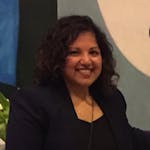Thousands of people have descended on the United Nations with one thing on their minds: the Sustainable Development Goals (SDGs). Specifically, they’ve gathered to assess where we are on the SDGs and how we can do better. What have been some of the highlights of those conversations?
The High-Level Political Forum (HLPF) on Sustainable Development, taking place from July 9-18, is the place to be this time every year to review how we are doing on the SDGs at the global level and also in local communities. While, overall, progress has been moving in the right direction, it has been patchy and not happening nearly fast enough.
This year, the HLPF puts a spotlight on the goals with an environmental focus, attempting to answer these four questions:
– What progress has been made since 2015 in ensuring every person across the globe has access to clean water and sanitation, and to affordable and clean energy?
– As the world continues to urbanize, are we building sustainable cities and communities, and are we shifting toward responsible consumption and production patterns?
– What are we doing to protect our ecosystems?
– How are we partnering to achieve the goals?
Key HLPF Takeaways
There have been robust discussions around these questions; here are eight main takeaways from the conversations so far.
- Three years in, there’s still a lot of enthusiasm around the 2030 Agenda and each of the 17 goals. As we make progress on one, we are seeing links across other issues. For example, improving access to clean water supports progress in sustainable infrastructure and the health sector, gender equality, and the reduction of inequalities.
- Data is king. Monitoring implementation means we need information. Information and official statistics cost a lot of money. Right now, only 17 countries have a fully funded national statistics plan! The gap in data funding is not insurmountable – only $200 million, or in World Cup terms, the salaries of two players, as Shaida Badiee stated.
- Access to clean water and sanitation (SDG 6) is not on track to be accomplished by 2030. In 2015 only 39% of the global population had access to a safely managed sanitation service. To raise awareness about the global water crisis, Mina Guli ran 40 marathons in 40 days, across six continents and along six riverbeds.
- It is within our reach to achieve affordable and clean energy for all (SDG 7). Last year, 17 countries generated more than 90% of their energy from renewables. Across the world, 133 million people benefit from off-grid renewables, which can enable rapid development gains to be made. The momentum around energy must now shift to address cooking fuels. “Cooking energy must become a top political priority, investing not only in clean technology but also in fuel, engaging women as agents of change in the distribution of energy services and equipment,” Sheila Oparaocha, Executive Director of ENERGIA, highlighted.
- The conversation continues to shift to the need to localize the SDGs, perhaps in part because SDG 11 (resilient and safe cities) is under review this year. For example, half of humanity, or 3.5 billion people, currently live in cities. With an estimated 2 billion people living in inadequate or informal housing, affordability, infrastructure, and the provision of services are big obstacles to address to ensure we can meet growing housing demands.
- Sustainable consumption and production require a shift in behavior on an individual level, not just in national policy. According to some experts, this goal (SDG 12) is the hardest to measure, as it is reflected in each consumer’s activities and purchases. However, the global conversation has resulted in 108 countries developing national policies.
- Protecting our ecosystems is no easy feat. Despite many efforts, challenges caused by climate change and man-made disasters and activities continue to take their toll on the planet. Best practices and innovative solutions must be shared, replicated, and scaled up.
- Partnerships are the only way we will meet the ambitious SDGs. Citizens, activists, civil society, and others must work together to ensure political support and action. And the private sector, the tech industry, and all stakeholders must take ownership of the SDGs, moving with urgency and doing their part.
Closing out the first week of HLPF, Kate Gilmore, UN Deputy High Commissioner for Human Rights, stated, “We are not just leaving people behind – in some cases we are pushing them behind.” As we continue the conversations at HLPF, a major question will be how and what each country is doing to reach out to those furthest behind. The presentations of 47 countries’ SDG national progress reports, called Voluntary National Reviews (VNRs), is an important moment to learn more.
Is your country among the 47 on the list? Tune in to the national presentations to learn about what’s happening around the world.



 View All Blog Posts
View All Blog Posts